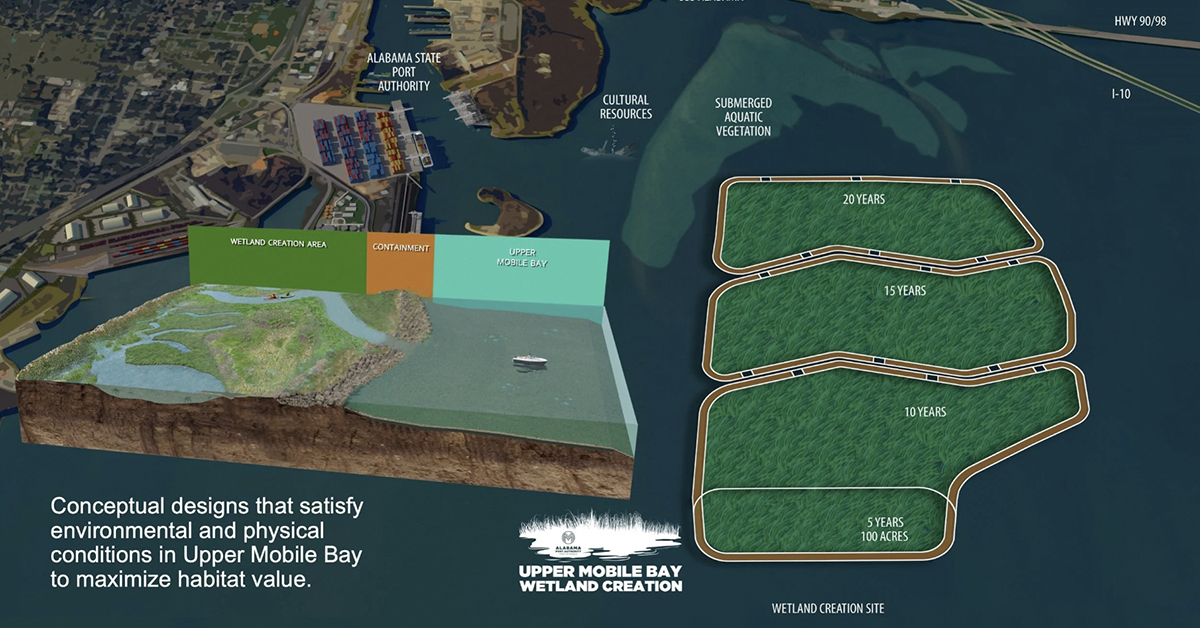The Alabama Port Authority has announced two significant milestones for the Upper Mobile Bay Wetlands Project, the only dedicated beneficial use site in Mobile Bay for maintenance material from the ship channel. The project has been selected to receive $24 million in RESTORE Act funding from the Alabama Department of Conservation and Natural Resources (ADCNR), and the Port of Mobile has executed its permit with the U.S. Army Corps of Engineers, clearing the way for construction to begin.
Located south of the Mobile Bay Causeway, the site will ultimately create hundreds of acres of wetlands, providing restored habitat that will support fisheries, wildlife and long-term coastal resiliency throughout Upper Mobile Bay. The project is designed to utilize eligible dredged material from the ship channel in a controlled, beneficial use setting.
“Wetland restoration in Mobile Bay is vital to our coastal communities, and I am proud to advocate for RESTORE Act funding for this project,” said Chris Blankenship, ADCNR commissioner. “I commend the port authority and the Corps for their vision and persistence in securing this permit, which ensures dredged material will be used in the most beneficial way possible.”
The Corps permit concludes a process that began in 2016, with engineering, design and permitting funded by the RESTORE Council in 2017. Throughout the effort, the port has worked closely with federal, state and local partners to expand the beneficial use of dredged material in Mobile Bay.
“Beneficial use is not just the right thing to do—it’s a strategic approach that allows us to grow responsibly while protecting the natural assets that make Alabama competitive,” said Doug Otto, director and CEO of the Alabama Port Authority. “We are especially grateful to Commissioner Blankenship for his leadership in advocating for RESTORE dollars. Having both the funding commitment and the [Corps] permit in hand is the catalyst we need to move this project forward and pave the way for additional beneficial use opportunities across Mobile Bay.”
Members of Alabama’s congressional delegation also voiced support for the project and the port’s broader beneficial use strategy.
“The Port of Mobile plays an important role in Alabama’s economy, generating more than $415 billion since 2019,” said Sen. Tommy Tuberville (R-Ala.). “In addition to being an economic driver for our state, I’m proud that the port also works hard to preserve our wetlands. There’s no reason why we can’t continue growing business and keeping Alabama beautiful at the same time.”
Sen. Katie Britt added, “Since I took office, I have worked diligently with the U.S. Army Corps of Engineers to ensure sediment is responsibly disposed of in Mobile Bay, including securing a provision in the Water Resources Development Act of 2024 to direct the Corps to use dredged material for beneficial use. I’m thrilled to see these developments for the Upper Mobile Bay Wetlands Project, and I remain committed to advocating for beneficial use of dredged material in the Mobile Harbor and ship channel. By working together at the state and federal levels, we will continue to strengthen Mobile Bay’s natural resources and reinforce the Port of Mobile as an economic engine for our state and nation.”
At a recent Propeller Club of Mobile meeting, Vern Gwin, chief of the Operations Division for the Mobile Engineer District, highlighted the region’s approach to dredged material and beneficial use.
“For years, dredged material was treated as waste—‘spoiled material,’ as we called it,” he said. “We do not use that term anymore. It is truly beneficial. It is essentially topsoil coming out of the Black Belt, some of the most fertile material you will find, and it settles right here in the Mobile ship channel.”
Gwin added that the Corps continues to expand beneficial use applications across the Mobile Bay system.
“Along the Dauphin Island Causeway, we are using about 700,000 cubic yards of material to build marsh that will strengthen the estuary in that part of the bay,” he said. “That means cleaner water and better habitat for birds and marine life in Mobile Bay, and I love seeing us use the material that way.”
The Upper Mobile Bay Wetlands Project builds on previous beneficial use collaborations between the port and the Corps associated with the deepening and widening of the 50-foot channel, including relic shell restoration, shoreline protection at Dauphin Island and wetlands restoration at Deer River.
Featured image caption: An artist’s rendering of the Upper Mobile Bay Wetlands Project. (Courtesy of Alabama Port Authority)




